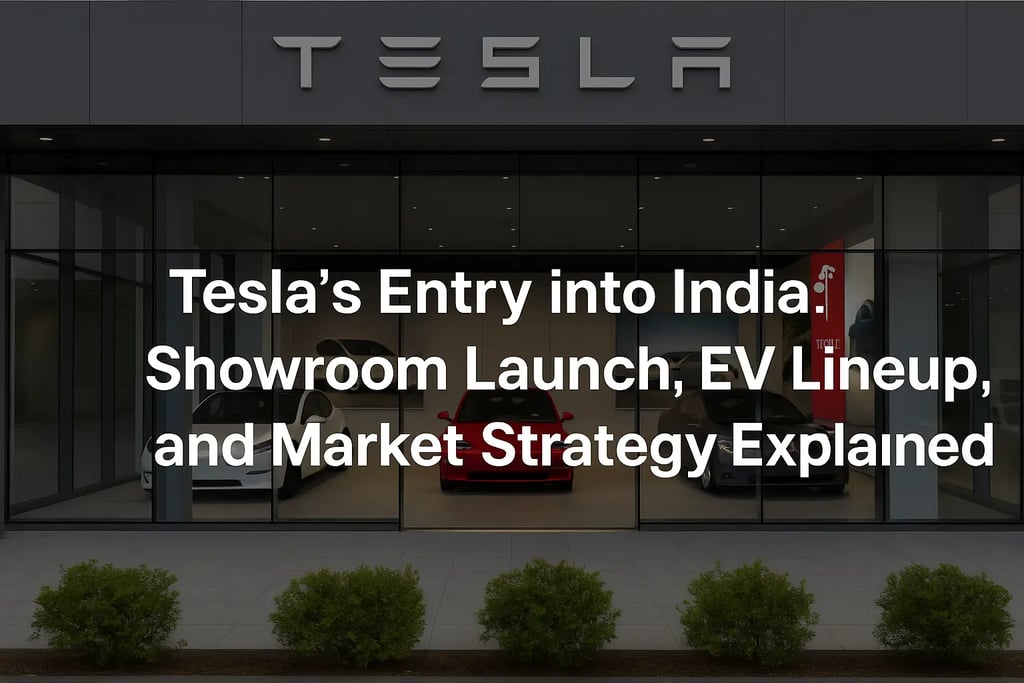Tesla in India: Showroom Launch, EV Lineup, and Market Strategy Explained
Tesla in India, enters the market with its first showroom in Mumbai. Discover its EV lineup, strategic plans, government support, and the future of electric vehicles in India.


Tesla’s Entry into India: A New Era for Electric Vehicles
Tesla's official debut in India marks a revolutionary chapter for the country’s automobile industry and its clean energy goals. With the launch of its first showroom in Mumbai, the electric vehicle (EV) giant aims to reshape India's transport landscape, drive sustainable mobility, and inspire broader EV adoption.
India presents a mix of exciting opportunities and complex challenges for Tesla. Backed by government incentives and a growing consumer base that values environmental sustainability, the market is ripe for transformation. However, hurdles like limited EV infrastructure and varying consumer awareness require thoughtful strategies. Tesla’s move is more than just a market entry—it's a statement of commitment to India’s green mobility mission.
Mumbai Showroom: Tesla’s Gateway to India
Tesla has inaugurated its first Indian showroom in Bandra, Mumbai—an upscale locality known for its tech-savvy and affluent population. This prime location offers maximum exposure and aligns with Tesla’s vision of urban sustainability.
The showroom reflects Tesla’s futuristic design sensibilities, with modern architecture and eco-friendly materials. Inside, customers can explore Tesla's popular models like the Model 3, Model Y, and Model S, each equipped with cutting-edge EV technology. Interactive panels, product demos, and educational zones help first-time EV buyers understand Tesla’s innovation.
This space also doubles as a community hub, hosting events, workshops, and awareness campaigns focused on clean energy and electric transport—emphasizing Tesla’s role in India’s environmental transition.
Tesla’s Vehicle Lineup for Indian Consumers
Tesla plans to introduce three main models tailored for Indian buyers:
Tesla Model 3:
A sleek and efficient sedan priced between ₹60–70 lakh. Ideal for city driving, it offers autopilot features and a premium EV experience at a relatively affordable price point.Tesla Model Y:
A compact SUV expected to range between ₹70–80 lakh. Its spacious design and long battery range make it perfect for Indian families seeking eco-friendly mobility without sacrificing comfort.Tesla Model S:
A premium luxury EV starting at ₹1 crore. Known for acceleration, performance, and top-tier tech, it caters to India’s high-end automobile segment.
Each model will benefit from Tesla’s expanding charging network and software updates, ensuring long-term usability in Indian conditions.
Tesla’s Market Strategy in India
Tesla’s strategy to capture the Indian market includes a mix of pricing, partnerships, localized production, and brand engagement:
Localized Pricing:
Tesla’s price points aim to strike a balance between affordability and luxury, targeting India’s upper-middle class and premium segments.Partnerships:
The company is working with Indian suppliers to build a domestic supply chain, supporting the "Make in India" initiative while lowering costs.Marketing:
Tesla leverages digital-first campaigns and social media to build hype and educate consumers. Launch events and influencer collaborations help build a loyal fan base.Charging Infrastructure:
A nationwide network of Superchargers is in the pipeline, starting with major metro areas. This tackles “range anxiety,” a common concern among Indian EV buyers.
Impact on the Indian EV Market
Tesla’s presence in India is expected to boost the entire EV ecosystem. Its reputation for quality and innovation raises consumer expectations, pushing other automakers—like Tata Motors, Mahindra, and Hyundai—to up their EV game.
As more premium options enter the market, Indian buyers will benefit from better choices and faster adoption rates. Tesla’s influence may also encourage increased investment in EV infrastructure and public-private collaborations to promote sustainability.
Government Support and EV Policies in India
India’s EV-friendly policies greatly support Tesla’s entry. The FAME II scheme offers subsidies for EV purchases, and various state governments—especially Maharashtra—provide tax breaks and registration waivers.
Additionally, the government promotes local EV manufacturing through capital subsidies and tax benefits. Tesla’s mission aligns closely with India’s goals for decarbonization and clean energy leadership, making this collaboration mutually beneficial.
Challenges and Opportunities for Tesla in India
Challenges:
High competition from local and global EV brands
Import duties and tariffs affecting final pricing
Infrastructure bottlenecks, including service centers and chargers
Regulatory hurdles in different states
Opportunities:
A young, urban, eco-conscious population
Potential for local manufacturing
Ability to shape consumer perceptions and dominate the premium EV space
Conclusion: Tesla Driving India’s EV Future
Tesla’s launch in India is more than a commercial move—it’s a catalyst for sustainable innovation. With the Mumbai showroom now operational and new EV models on the horizon, Tesla is well-positioned to influence how India adopts electric vehicles in the coming decade. Its success will not only redefine luxury transport but could also pave the way for a cleaner, greener future on Indian roads.
